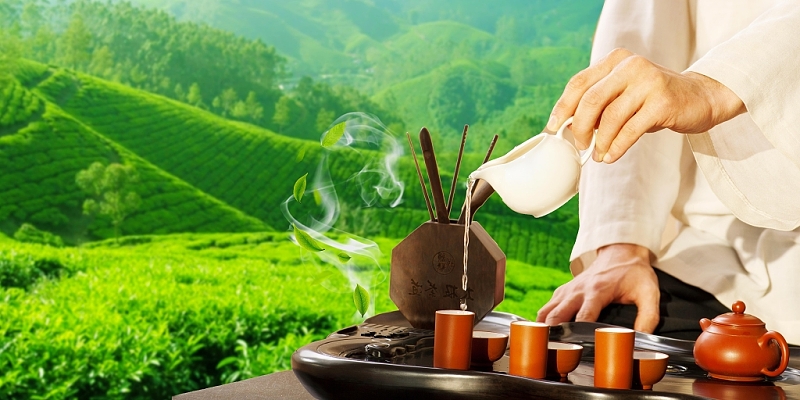Nestled in the rolling hills of Wuhu, Anhui Province, 芜湖毛峰茶 (Wuhu Maofeng Tea) stands as a testament to China’s storied tea culture. Revered for its delicate flavor, vibrant appearance, and meticulous craftsmanship, this green tea has charmed palates for centuries. Let us embark on a journey through its history, terroir, and timeless allure.

Historical Tapestry: From Imperial Courts to Modern Times
Wuhu Maofeng’s legacy dates back to the Ming Dynasty, when tea masters in the region began experimenting with oxidation techniques. By the Qing Dynasty, it had earned acclaim as a “tribute tea,” favored by scholars and nobility for its refined taste. The name Maofeng (Hairy Peak) refers to the tea’s downy buds, which resemble the mist-capped mountains of its birthplace. Though production declined during turbulent periods, the 1980s saw a revival, with artisans blending traditional methods with modern standards. Today, it remains a symbol of Wuhu’s agricultural pride.
Terroir: The Dance of Land and Climate
Grown in the ecological haven of Wuhu’s Yuxi District, Maofeng thrives in:
- Soil: Loamy, well-drained earth enriched with minerals from the Yangtze River Delta.
- Climate: Warm, humid air filtered by mist from nearby lakes, creating a microclimate ideal for slow leaf growth.
- Elevation: 100–300 meters above sea level, where tea bushes bask in gentle sunlight and cool breezes.
This environment imbues the leaves with a floral sweetness, often likened to orchid and chestnut.
Craftsmanship: The Alchemy of Hands and Fire
The tea’s production is a labor-intensive art:
- Plucking: Only the tender bud and one leaf are harvested in early spring.
- Withering: Leaves are spread on bamboo mats under natural sunlight to reduce moisture.
- Fixation: Skilled hands toss the leaves in woks at 180–200°C to halt oxidation.
- Rolling: Leaves are gently shaped into slender, curved strips.
- Drying: Slow-baked over charcoal to preserve fragrance and flavor.
The result? Jade-green leaves that unfurl to reveal a luminous amber liquor.
Tasting Ritual: Brewing Perfection
To savor Wuhu Maofeng’s full glory:
- Water: Use soft water (e.g., mineral or filtered) heated to 75–80°C.
- Ratio: 3g of tea per 150ml of water.
- Infusion: Steep for 2–3 minutes, then decant.
The first brew releases a grassy freshness; the second, a nutty sweetness. Repeat up to four times, each cup unveiling new layers of flavor.
Quality Authentication: Spotting the Genuine Article
Authentic Wuhu Maofeng is distinguished by:
- Appearance: Smooth, needle-like leaves with a silvery fuzz.
- Aroma: Delicate notes of chestnut and fresh bamboo.
- Liquor: Bright golden-green hue.
- Taste: A harmonious balance of astringency and umami, with a lingering finish.
Beware of imitations—true Wuhu Maofeng bears a GI (Geographical Indication) tag.
Grades and Pricing: Rarity and Prestige
The tea is classified into three tiers:
- Supreme Grade: Handpicked buds, priced at ¥2,800–4,500/500g.
- Premium Grade: Young leaves, costing ¥1,000–2,200/500g.
- Standard Grade: Mature leaves, available for ¥500–900/500g.
Limited annual yields (under 8,000kg) ensure its exclusivity.
Healthful Benefits: Nature’s Medicine in a Cup
Rich in polyphenols and vitamins, this tea offers:
- Cardiovascular Support: Lowers cholesterol and improves circulation.
- Detoxification: Aids digestion and purifies the liver.
- Antioxidant Power: Combats free radicals, slowing aging.
- Mental Clarity: Enhances focus without the jitters of coffee.
Cultural Significance: More Than a Beverage
In Wuhu, Maofeng Tea is woven into daily life—served to guests as a gesture of respect, sipped during festivals, and exchanged as a symbol of friendship. Its revival in the 1990s, led by local innovators, transformed it into a beacon of rural prosperity, earning accolades like the “China Green Food Award” (2005) and “Anhui Provincial Heritage Tea” (2010).
Conclusion
Wuhu Maofeng Tea is not merely a drink—it is a journey through time, a celebration of nature’s bounty, and a testament to human ingenuity. Whether enjoyed in a bustling city teahouse or a tranquil mountain villa, this emerald elixir continues to enchant, one sip at a time.



